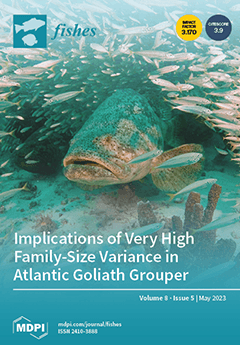A 10 week feeding trial was conducted to evaluate the potential effects of ginger powder (GP) and ginger extract nanoparticles (GNPs) on the growth parameters, digestive enzymes (lipase and amylase) activities, blood hematology, blood biochemical indices, immune indices (interleukin 10, immunoglobulin M, nitric
[...] Read more.
A 10 week feeding trial was conducted to evaluate the potential effects of ginger powder (GP) and ginger extract nanoparticles (GNPs) on the growth parameters, digestive enzymes (lipase and amylase) activities, blood hematology, blood biochemical indices, immune indices (interleukin 10, immunoglobulin M, nitric oxide, and lysozymes), antioxidant activity, histological characteristics of kidney, spleen, liver, and intestine, and resistance to
Aeromonas hydrophila or
Pseudomonas putida infection in Nile tilapia,
Oreochromis niloticus. Fish (
n = 225, 27.01 ± 0.15 g) were stocked in 15 glass tanks (50 × 40 × 60 cm) and randomly allocated to five experimental treatments (TRTs) in triplicate (15 fish/replicate, 45 fish/TRT), consisting of five isocaloric–isonitrogenous diets. The treatments comprised the basal diet (1) without any additives (control group, CON), (2) with 0.5% GP (GP0.5), (3) with 1% GP (GP1), (4) with 0.5% GNPs (GNPs0.5), and (5) with 1% GNPs (GNPs1). Fish were manually fed to satiety three times a day (at 9 a.m., 12 p.m., and 2 p.m.). Fish were weighed at the start of the experiment, then the body weight, weight gain, feed intake, and feed conversion ratio were determined at the end of the experiment. At the end of the feeding period, 15 fish/TRT were intraperitoneally inoculated with two pathogenic bacterial strains (
A. hydrophila or
P. putida) in two separate challenge tests. Blood samples were collected from each TRT at two aliquots for hematological and biochemical analysis at the end of the feeding period. A significant improvement in fish growth was observed in GP and GNPs TRTs compared to the control group. There were no significant changes in the total amount of feed intake/fish in response to the experimental diets. Diets enriched with GNPs, particularly the GNPs1 TRT, resulted in a significant increase (
p < 0.05) in digestive enzyme activity (lipase and amylase), serum growth hormone level, proteinogram, and immune indices (lysozyme, immunoglobulin M, interleukin 10, and nitric oxide). In addition, a significant increase in hepatic antioxidant enzymes (superoxide dismutase, reduced glutathione, and catalase) was observed in fish fed with GNPs-enriched diets. Survival percentages following bacterial challenge were higher in GNPs1, followed by GP1 and GNPs0.5 TRTs. Normal histomorphology was found in liver, kidney, and spleen tissues in all experimental TRTs. We conclude that GP and GNPs could be included in Nile tilapia diets for promoting fish growth, immunity, antioxidant status, and disease resistance without harming organ functions. In particular, the most effective treatment was GNPs1.
Full article





